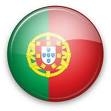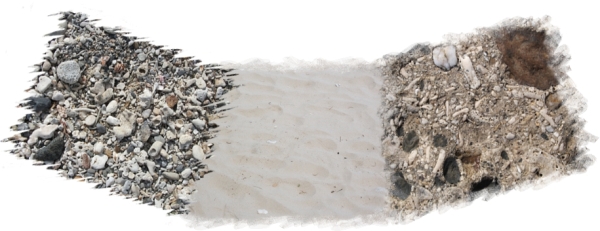 Praias
Praias
As praias são zonas costeiras criadas pelos sedimentos de partículas, areia solta, cascalho ou conchas.
Areia: A areia varia de textura conforme o tamanho dos grãos (entre 0,02mm a 2mm, se forem maiores é considerado cascalho) e é maioritariamente constituída por quartzo (sílica) de origem terrestre e material carbonatado de origem marinha (proveniente do desgaste das conchas de moluscos e esqueletos de outros animais).
Cascalho: é qualquer rocha que tem ao menos dois milímetros na sua menor dimensão e não mais do que 75 milímetros.
Conchas: restos de moluscos que por acção das correntes marítimas são depositadas na zona costeira.
Calcário biogénico ou conquífero: Muitos seres vivos são capazes de absorver da água do mar iões de Cálcio(Ca2+) e Carbonato (CO32-) com os quais formam as suas conchas, ou outros materiais calcíticos. Um exemplo destes são os corais. Quando estes seres morrem as suas partes moles são rapidamente dissolvidas restando um sedimento constituído por fragmentos de conchas e outros materiais calcíticos. Estes materiais por acção da pressão e da temperatura sofrem a diagénese (compactação e cristalização de materiais que cimentam os grãos dos sedimentos), formando as rochas conquíferas. A sua coloração vai de branco a preto, podendo ser cinzento claro ou cinzento escuro, muitos calcários apresentam cores avermelhadas, amareladas, azuis ou verdes dependendo do tipo e quantidade de impurezas que apresentam. As principais impurezas que são as sílicas, argilas, fosfatos, carbonato de magnésio, gipso, glauconita, fluorita, óxidos de ferro, magnésio, sulfetos, siderita,sulfato de ferro dolomita e matéria orgânica entre outros. É a presença e tipo de impurezas que determina a coloração dos arenitos; por exemplo, grandes quantidades de óxidos de ferro, fazem as rochas vermelhas. Em águas com níveis de oxigênio baixo o Ferro existe como nutriente para as plantas sob a forma de iões de ferro (Fe2+), estes locais são frequentemente paraísos para as plantas.
A praia do Cristo Rei

A praia do Cristo Rei é uma área junto ao mar, aprazível e de lazer para muitas pessoas. Com uma extensão relativamente pequena, umas dezenas de metros. No entanto nela podemos encontrar em zonas bem diferenciadas a areia de grão fino, o cascalho, material carbonatado e rochas biogénicas o calcário conquifero.
Para fazer o found it desta Earth Cache terá que primeiro responder ao owner por mail às seguintes questões:
1 - Que tipos de sedimentos podem ser encontrados no Waypoint 1, Waypoint 2 e no waypoint 3?
2 – Qual a cor predominante do Calcário Biogénico e qual a razão desta cor?
Desde há algum tempo que as fotos nas EC deixaram de ser obrigatórias, no entanto serão sempre agradáveis de ver.
 Beaches
Beaches
The beaches are created by coastal sediment particles, loose sand, gravel or shells.
Sand: varies depending on the texture of the grain size (from 0.02 mm to 2 mm, larger is considered gravel) and is mostly composed of quartz (silica) of terrestrial origin and carbonated material of marine origin (from the weathering of shells skeletons of shellfish and other animals).
Gravel: is any rock that has at least two millimeters in its longest dimension and not more than 75 mm.
Shells: the remains of shellfish that by the action of ocean currents are deposited in the coastal zone.
Biogenic limestone or Lime conquina: Many living beings are capable of absorbing from the seawater calcium ions (Ca2+) and carbonate (CO32-) with which they form their shells and other calcitic materials. One example of this are the corals. When these creatures die their soft parts are quickly dissolved leaving a sediment formed by fragments of shells and other calcitic materials. These materials through the action of pressure and temperature suffer diagenesis (compaction and crystallization of materials that cement the grains of sediments) forming the Lime conquina. The color ranges are from white to black, may be light gray or dark gray, many limestone exhibit colors red, yellow, blue or green depending on the type and quantity of impurities present. The main impurities are silica, clay, phosphate, magnesium carbonate, gypsum, glauconite, fluorite, iron oxides, magnesium, sulfides, siderite, dolomite, iron sulfate and organic matter among others. The presence and type of impurities is what determines the color of sandstone, for example, large amounts of iron oxides, make the rocks red. In waters with low oxygen levels the iron exists as a nutrient for plants in the form of iron ions (Fe2+), these sites are often havens for plants.
The beach at Cristo Rei

The Cristo Rei Beach is a seaside area, comely and recreation for many people. With a relatively small extent, a few tens of meters. However in it we can find in well-differentiated fine-grained sand, gravel rocks and biogenic material carbonated lime conquina.
To log this as a found you have to respond to the owner by mail to the following questions:
1 - What types of sediments can be found at Waypoint 1, Waypoint 2 and Waypoint 3?
2 - What is the predominant color of the biogenic limestone and why do you think it has that color?
For some time the photos in the EC no longer mandatory, but will always be nice to see.

